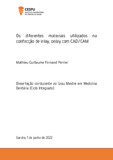| dc.contributor.advisor | COELHO, JOSÉ ALBERTO GONÇALVES DA ROCHA | |
| dc.contributor.author | PERRIER, Mathieu Guillaume Fernand | |
| dc.date.accessioned | 2022-11-07T13:31:46Z | |
| dc.date.available | 2022-11-07T13:31:46Z | |
| dc.date.issued | 2022 | |
| dc.identifier.uri | http://hdl.handle.net/20.500.11816/4092 | |
| dc.description.abstract | Introdução:
Os objetivos desta revisão sistemática foram de avaliar a taxa de sucesso, a perda estética e a adaptação marginal de diferentes materiais no fabrico de restaurações indirectas (inlay/onlay) e em particular de blocos cerâmicos híbridos com diferentes tipos de cerâmica.
Métodos:
A pesquisa foi realizada na base de dados PubMed usando uma combinação de diferentes termos científicos. A pesquisa identificou 418 artigos, dos quais 9 estudos foram considerados mais relevantes para este estudo e 7 obtidos no pubmed sem o uso de MeSH Terms.
Resultados:
Estes estudos forneceram dados importantes sobre as várias vantagens e desvantagens dos materiais utilizados na técnica Computer Aided Design and Manufacturing (CAD/CAM), que é uma tecnologia recente que permite esculpir restaurações diretamente em blocos de material utilizando fresadoras controladas por computador. As restaurações indirectas ou inlay/onlay tratadas neste estudo são restaurações de nova geração. Não são ainda muito utilizados devido ao seu elevado custo, mas estão a tornar-se cada vez mais populares.
Conclusão:
Em geral, estudos têm demonstrado que os materiais totalmente cerâmicos ou híbridos cerâmicos têm o seu lugar na medicina dentária no que diz respeito à taxa de sucesso, perda estética e adaptação marginal, dependendo do paciente e dos seus fatores ambientais, tais como higiene oral, consumo de alimentos ou bebidas que mancham, ou força oclusal. | pt_PT |
| dc.description.abstract | Introduction:
The aim of this systematic review was to evaluate the success rate, aesthetic loss and marginal adaptation of different materials in the fabrication of indirect (inlay/onlay) restorations and in particular hybrid ceramic blocks with different types of ceramics.
Methods:
A PubMed database search was performed using a combination of different scientific terms. The search identified 418 articles, of which 9 studies were considered most relevant for this study and 7 obtained on PubMed without the use of MeSH Terms.
Results:
These studies provided important data on the various advantages and disadvantages of the materials used in the CAD/CAM technique, which is a recent technology that allows restorations to be carved directly into blocks of material using computer-controlled cutters. The indirect or inlay/onlay restorations treated in this study are new generation restorations. They are not yet widely used due to their high cost, but are becoming increasingly popular.
Conclusion:
In general, studies have shown that all-ceramic or hybrid ceramic materials have their place in dentistry with regard to success rate, aesthetic loss and marginal adaptation, depending on the patient and their environmental factors, such as oral hygiene, consumption of food or drink that stains, or occlusal force. | pt_PT |
| dc.language.iso | por | pt_PT |
| dc.rights | info:eu-repo/semantics/openAccess | pt_PT |
| dc.subject | CAD/CAM | pt_PT |
| dc.subject | Onlay | pt_PT |
| dc.subject | Inlay | pt_PT |
| dc.title | Os diferentes materiais utilizados na confecc¸ão de inlay, onlay com CAD/CAM. | pt_PT |
| dc.type | info:eu-repo/semantics/masterThesis | pt_PT |
| dc.identifier.tid | 203081439 | pt_PT |
| thesis.degree.name | Mestrado em Medicina Dentária | pt_PT |

